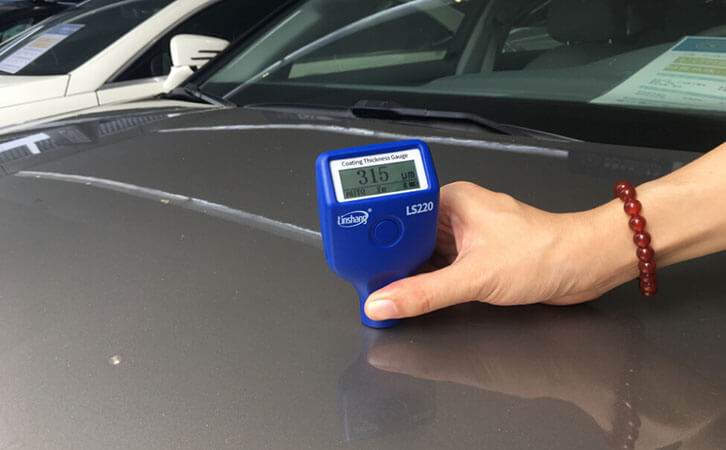Delamination of Car Paint and Paint Thickness Gauge
The painted surface of the car is divided into four layers in the traditional painting process, which together play a protective and beautiful function on the body. With the improvement of the process, the complex car paint can reach seven or eight layers. Taking the four layers of traditional craftsmanship, from the inside to the outside, they are electrophoresis, intermediate coating, colored paint and varnish. In general, the thickness of the electrophoretic layer is 20 microns, the thickness of the middle coating layer is 30 microns, the thickness of the colored paint layer is 20 microns and the thickness of the varnish layer is 30 microns. In other words, the thickness of the car paint above 100 microns can basically be regarded as qualified, here we can use the paint thickness gauge to measure the car paint thickness.
1. Electrophoresis layer (cathode electrophoresis)
Put the pre-treated white car body in the electrophoretic paint with cations, apply positive electricity to the anode tube on the bottom of the electrophoresis tank and the wall. Then apply negative electricity to the body, so a potential difference will be formed between the anode tube and the body. The positively charged cationic electrophoretic paint will migrate to the white body under the action of the potential difference and eventually adsorb on the body to form a dense paint film. This layer of paint film is called electrophoretic paint. The electrophoretic paint is baked. The oven becomes an electrophoretic layer after drying.
The electrophoretic layer can be approximately considered as the paint layer directly attached to the body steel plate, so it is also called a primer. In fact, there is a layer formed in the pre-treatment between the electrophoretic layer and the steel plate. The phosphate coating is very thin, the thickness is only a few μm measured with dry film thickness gauge. The role of the electrophoretic layer is mainly two, one is to prevent rust and the other is to improve the binding force of the paint layer. The anti-rust ability of the electrophoretic layer is the most important and the most critical of the four paint layers.
2. Middle coating
The middle coating is a paint layer between the electrophoretic layer and the colored paint layer. The middle coating is sprayed by a robot. Its function is relatively simple. It has anti-ultraviolet rays, protects the electrophoretic layer, improves the rust prevention ability and takes into account the smoothness and impact resistance of the paint surface. Finally, it can also provide some adhesion for the paint layer. It can be seen that the middle coating is actually a lacquer layer connected to the bottom, which plays a connecting role for the two functional coatings of the electrophoretic layer and the color paint layer.
3. Color paint layer
The color paint layer, as the name suggests, is the color paint layer, which provides us with the most direct color perception. Colors such as red, black, kingfisher blue, Pittsburgh gray and supersonic quartz white. The quality of the spray paint layer directly determines the performance of the body color and the functionality is very important.
4. Varnish layer
The varnish layer is the outermost layer of the car paint, a transparent paint layer that we can directly touch with our fingertips. The role of the varnish is mainly to improve the gloss of the paint surface, improve the texture and prevent UV rays. Although there are several layers of paint on the original car, it is still relatively thin. In the later stage, if you are worried about car paint, you need to do crystal plating or invisible car clothing protection.
5. Car paint thickness measurement
The function of the paint thickness gauge is simply to nondestructively measure the thickness of the car paint coating. Not only can the thickness of the car paint be measured, the paint thickness gauge can also check the material of the cover and determine whether the cover has been replaced, so it is also an essential artifact when buying used cars.
The paint thickness gaugemainly uses high-precision probes to sense the coating layer of the measured object at different frequencies and wafer sizes. Then chooses different methods to measure according to different materials and accuracy requirements and finally assists with electronic correction and display function. Therefore, the user must choose and use different paint thickness gauges according to different needs and materials.
- High precision coating thickness gauge for used car
- Automotive paint protection films coating thickness gauge
- Plating Thickness Measuring Instrument for Detecting Anti-corrosion Coating
- Linshang LS220, LS191, LS160A– Necessary for Car Cover Inspection
- Coating Thickness Gauge for Second Hand Vehicle
- Zero Adjustment Step of Coating Thickness Gauge
